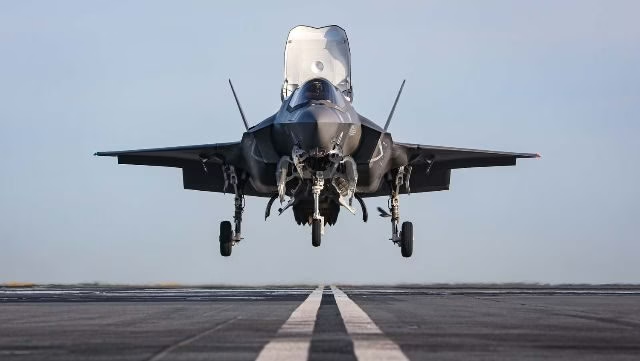UK’s $110M F-35B stranded in India: Tech secrets at risk?


Summary
– A British F-35B fighter jet is stranded in India after an emergency landing on June 14, 2025.
– The jet, grounded by a hydraulic failure, sits at Thiruvananthapuram airport.
– UK lawmakers raise concerns over the security of the jet’s stealth technology.
– Indian authorities assist, highlighting strong UK-India defense ties.
– The incident tests the F-35 program’s reliability in global operations.
A British Royal Navy F-35B Lightning II fighter jet, one of the world’s most advanced warplanes, has been grounded at Thiruvananthapuram International Airport in Kerala, India, since June 14, 2025, following an emergency landing during a routine mission in the Indo-Pacific. The jet, part of the HMS Prince of Wales Carrier Strike Group, was forced to divert to the civilian airport after failing to return to its carrier, initially due to low fuel and adverse weather, and later due to a hydraulic system failure.
The incident has raised concerns in the United Kingdom about the security of the jet’s sensitive technology, prompting questions from lawmakers and highlighting the complexities of operating cutting-edge military hardware in a geopolitically sensitive region. Indian authorities have provided logistical support, but the jet remains under tight British security, with no clear timeline for its return to service.
The F-35B, valued at over $100 million, was participating in Operation Highmast, a major British naval deployment to the Indo-Pacific aimed at reinforcing alliances and countering regional tensions, particularly with China. The mission, involving the HMS Prince of Wales and up to 4,500 personnel, underscores the United Kingdom’s commitment to maintaining a strategic presence in the region.
The aircraft, operating roughly 100 nautical miles off Kerala’s coast, declared an emergency and was cleared to land by India’s Integrated Air Command and Control System. Indian Air Force officials confirmed the jet was flying outside India’s Air Defence Identification Zone, with Thiruvananthapuram designated as its emergency recovery airfield. A spokesperson for the Indian Air Force stated, “On having declared a diversion off an emergency, the F-35B was detected and identified by the IAF’s IACCS network and cleared for recovery.”
The F-35B: a technological marvel
The F-35B Lightning II, developed by U.S. defense contractor Lockheed Martin, represents the pinnacle of modern military aviation. Designed for short take-off and vertical landing, the single-seat, single-engine supersonic jet is tailored for operations from aircraft carriers and amphibious assault ships.
Powered by a Pratt & Whitney F135 engine, the aircraft integrates stealth coatings, advanced sensor fusion, and electronic warfare capabilities, enabling it to detect and engage targets across air, land, and sea. Its radar cross-section, roughly the size of a golf ball, makes it nearly invisible to enemy radar, a critical advantage in contested environments. The jet’s data-sharing infrastructure allows seamless coordination with allied forces, cementing its role as a cornerstone of NATO’s air strategy.
Compared to other carrier-based fighters, such as the U.S. Navy’s F/A-18 Super Hornet or Russia’s Su-33, the F-35B offers unmatched versatility. The Super Hornet, while reliable and combat-proven, lacks the stealth and sensor capabilities of the F-35B. The Su-33, designed for Russia’s aircraft carriers, is less advanced in electronic warfare and data integration.
However, the F-35B’s complexity comes with challenges. The jet’s maintenance requirements are notoriously high, with a 2024 U.S. Department of Defense report noting that critical failures occur more frequently than prescribed standards, and repair times often exceed expectations.
The Incident and its aftermath
On the night of the emergency landing, the F-35B touched down safely at Thiruvananthapuram around 9:28 p.m. local time. Indian authorities provided immediate support, including refueling, but subsequent attempts to return the jet to the HMS Prince of Wales were thwarted by a hydraulic system failure. Hydraulics are critical for controlling the jet’s landing gear, brakes, and flight surfaces, and a failure in this system renders the aircraft unflyable.
A Royal Navy maintenance team, airlifted to the scene via an AW101 Merlin helicopter, assessed the damage but was unable to resolve the issue. The British High Commission in Bengaluru confirmed, “A UK F-35 aircraft was unable to return to HMS Prince of Wales due to adverse weather conditions. The aircraft has subsequently developed an engineering issue whilst on the ground, which precluded its return to the Carrier.”
The jet, stationed at Bay 4 of the airport, has remained under strict security, guarded by both British personnel and India’s Central Industrial Security Force. Initially parked in the open, exposed to Kerala’s monsoon rains, the aircraft sparked concerns about potential damage and security risks. The Royal Navy initially declined an offer from Air India to move the jet to a hangar, citing concerns over protecting its advanced technology.
However, after two weeks, British authorities agreed to relocate the aircraft to a maintenance hangar once a specialist team and equipment arrive from the United Kingdom. A British High Commission spokesperson noted, “We are working to repair the UK F-35B at Thiruvananthapuram International Airport as quickly as possible. We thank the Indian authorities for their continued support.”
Security concerns and political reactions
The prolonged grounding of the F-35B has drawn attention from British lawmakers, particularly over the risk of exposing its classified technology. The House of Commons has pressed the government for assurances that the jet’s sensitive systems, including its stealth coatings and sensor suite, remain secure while stationed at a civilian airport.
A statement from the Ministry of Defence emphasized, “The aircraft remains under strict British control, with Royal Air Force personnel guarding it 24/7.” Indian officials have reiterated their commitment to supporting their British allies, with the Indian Air Force providing logistical assistance throughout the ordeal.
The incident has also fueled speculation in Indian media and online platforms. Some reports suggested the emergency landing was prompted by more than just weather and fuel issues, with hydraulic failure emerging as the primary cause only after initial repairs failed. The lack of detailed British media coverage has led to claims of deliberate suppression by the Ministry of Defence, with aviation expert Guy Gratton noting on Indian television that the silence may reflect efforts to downplay an “embarrassing” situation.
Geopolitical implications
The emergency landing highlights the deepening defense ties between the United Kingdom and India, a key strategic partner in the Indo-Pacific. The HMS Prince of Wales was engaged in joint maritime exercises with the Indian Navy as part of Operation Highmast, a mission that underscores the United Kingdom’s pivot to the region amid rising tensions with China.
India’s role as a neutral player, maintaining relations with both Western powers and nations like Russia, adds complexity to the situation. The decision to land at a civilian airport rather than a military base reflects India’s designation of Thiruvananthapuram as an emergency recovery airfield, a testament to the trust between the two nations.
Historically, similar incidents have tested international partnerships. In 2016, a U.S. F-22 Raptor made an emergency landing in Canada due to mechanical issues, remaining grounded for days under tight security. Unlike the F-22 incident, which occurred in a NATO ally’s territory, the F-35B’s presence in India raises unique questions about technology security in a non-NATO country.
India’s own air force operates French Rafale jets and Russian-designed aircraft, with no F-35s in its arsenal, though former U.S. President Donald Trump suggested earlier in 2025 that India could be considered for the program.
Operational challenges and future steps
Repairing the F-35B presents significant logistical hurdles. If on-site repairs remain unsuccessful, defense officials have indicated the jet may need to be airlifted back to the HMS Prince of Wales or the United Kingdom via a military transport aircraft, such as a C-17 Globemaster.
This approach mirrors a 2020 incident in which a U.S. C-17 was stranded in Bangladesh due to mechanical issues and required airlifting. The complexity of the F-35B’s systems, coupled with the need for specialized equipment, underscores the challenges of maintaining fifth-generation fighters during overseas deployments.
The incident has also reignited scrutiny of the F-35 program’s reliability. The 2024 U.S. Department of Defense report highlighted that the F-35B’s mean time between critical failures and maintenance events falls short of expectations, contributing to higher-than-anticipated costs. For the Royal Navy, the grounding of a flagship asset during a high-profile mission raises questions about operational readiness and the feasibility of projecting power in distant regions.
A test of trust and technology
The grounding of a British F-35B in India is more than a technical hiccup; it is a test of the strategic partnership between London and New Delhi, as well as a reminder of the vulnerabilities inherent in deploying cutting-edge military technology. The swift response from Indian authorities and the ongoing cooperation reflect the strength of bilateral ties, yet the prolonged delay in repairs fuels speculation about the jet’s condition and the broader reliability of the F-35 program.
As the United Kingdom awaits the arrival of its specialist team, the incident serves as a case study in the delicate balance of trust, security, and operational demands in modern warfare.
***
Follow us everywhere and at any time. BulgarianMilitary.com has responsive design and you can open the page from any computer, mobile devices or web browsers. For more up-to-date news, follow our Google News, YouTube, Reddit, LinkedIn, and Twitter pages. Our standards: Manifesto & ethical principles.
How we confirmed this story:
- BulgarianMilitary.com cross-references open-source intelligence, including battlefield maps and geolocated footage, to confirm military movements and resource claims. We analyze official statements, expert insights from defense analysts, and economic data to ensure accuracy.
- Social media posts are scrutinized and validated against primary sources, such as government reports and on-the-ground accounts. Our rigorous process guarantees reliable, fact-based reporting.















